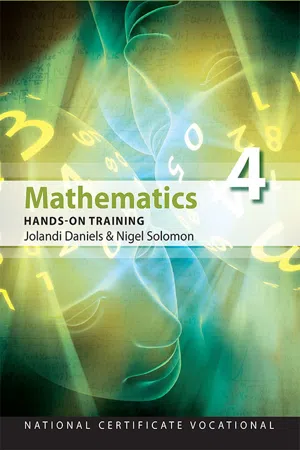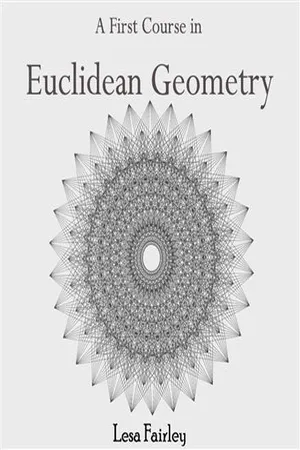Mathematics
Angles
Angles are geometric figures formed by two rays with a common endpoint, known as the vertex. They are measured in degrees and can be classified based on their size, such as acute (less than 90 degrees), right (exactly 90 degrees), obtuse (more than 90 degrees but less than 180 degrees), and straight (exactly 180 degrees). Angles play a fundamental role in geometry and trigonometry.
Written by Perlego with AI-assistance
Related key terms
1 of 5
12 Key excerpts on "Angles"
- Kevin Corner, Leslie Jackson, William Embleton(Authors)
- 2013(Publication Date)
- Thomas Reed(Publisher)
7 TRIGONOMETRY AND GEOMETRY An angle is the corner of two joining lines and the magnitude of an angle is measured in either degrees or radians. Measurement of Angles The most common unit of angle measurement that is known is probably the degree . There are 360 ◦ in a circle and so a degree is one three-hundred-and-sixtieth part of a circle. The symbol for a degree is ◦ and so there are 360 ◦ in a circle. Figure 7.1 shows a quarter of a circle which is 90 ◦ and is termed a right-angle , an angle which is less than 90 ◦ (Figure 7.2) is called an acute angle, greater than 90 ◦ but less than 180 ◦ (Figure 7.3) is an obtuse angle, and greater 180 ◦ (Figure 7.4) is a reflex angle. Right angle 90° Figure 7.1 142 • Mathematics Acute angle <90° Figure 7.2 90° < Obtuse angle < 180° Figure 7.3 Reflex angle >180° Figure 7.4 One sixtieth part of a degree is termed one minute and the sixtieth part of a minute is one second . Symbols are used to represent degrees, minutes and seconds. 60 s = 60 = 1 min; 60 min = 60 = 1 ◦ ; 360 ◦ = 1 circle. An angle of 35 degrees 23 minutes and 15 seconds is written as 35 ◦ 23 15 . Notation depends on the circumstance: some situations require Angles to be given in decimal form accurate to, say, 3 decimal places; others require answers correct to the nearest tenth of one minute, for example 35 ◦ 25.7 ; and others may require an accuracy correct to the nearest second, for example 35 ◦ 23 15 . Circular measure A radian is the angle subtended at the centre of a circle by an arc equal in length to the radius (Figure 7.5). Trigonometry and Geometry • 143 Therefore 2 π radians = 360 ◦ 1 radian = 180 ◦ π ∼ = 57.3 ◦ or 57 ◦ 17 45 1 ◦ = π 180 ∼ = 0. 01745 radians r θ s A Figure 7.5 θ is in radians Length of arc, s = r · θ Area of sector, A = 1 2 · r 2 · θ Similarly, if a wheel of 0.3 m radius turns through 4 rad in 1 s, then a point on the rim moves at a rate of 4 × 0.3 = 1.2 m/s.- eBook - PDF
- Paul A. Calter, Michael A. Calter(Authors)
- 2011(Publication Date)
- Wiley(Publisher)
We will touch only on Euclidean geometry in this chapter and cover some analytic geometry later. Other geometries, those of more than three dimensions, non-Euclidean geometries, projective geometry, fractal geometry, and more, are subjects for other texts. 1 2 diameter ″ 5 ″ — 3 4 ″ — FIGURE 6–1 176 Chapter 6 ◆ Geometry Initial side Terminal side FIGURE 6–4 An angle formed by rotation. B A Vertex Side Side C FIGURE 6–3 An angle. (a) Line segment Ray (b) FIGURE 6–2 6–1 Straight Lines and Angles The straight line is not new to us, for we studied it in some detail in the last chapter. Here we will add a second straight line which intersects the first at an angle. Angles A line segment is that portion of a straight line lying between two endpoints [Fig. 6–2(a)]. A ray, or half-line, is the portion of a line lying to one side of a point (end-point) on the line [Fig. 6–2(b)]. An angle is formed when two rays intersect at their endpoints, Fig. 6–3. The point of intersection is called the vertex of the angle, and the two rays are called the sides of the angle. The angle shown in Fig. 6–3 can be designated in any of the following ways: The symbol means angle, so means angle B. An angle can also be thought of as having been generated by a ray turning from some initial position to a terminal position (Fig. 6–4). We adopt the usual convention that an angle is positive when formed by a counterclockwise rotation, as in the figure, and negative when formed by a clockwise rotation. One revolution is the amount a ray would turn to return to its original position. The units of angular measure in common use are the degree and the radian. The measure of an angle is the number of units of measure it contains. Two an- gles are equal if they have the same measure. - Available until 8 Feb |Learn more
- J Daniels, N Solomon, J Daniels, N Solomon(Authors)
- 2014(Publication Date)
- Future Managers(Publisher)
– Measure and construct different types of Angles. – Investigating the properties of triAngles by means of construction. Use geometry of straight lines and triAngles to solve problems and justify relationships in geometric figures Introduction Straight lines define Angles and properties of triAngles. This section will revise the geometry of straight lines and triAngles which have been discussed in the Senior Phase (Grades 7, 8 and 9). 3.2 3.2.1 201 Chapter 3 Space, shape and measurement Geometry of straight lines The geometry of straight lines can be defined in terms of Angles. angle arm arm vertex The two arms (straight lines), joined at the vertex, define different Angles as summarised in the table below. Type of angle Description Sketch Acute angle An angle less than 90° Right angle An angle equal to 90° Obtuse angle An angle greater than 90°, but smaller than 180° Straight angle An angle equal to 180° Reflex angle An angle greater than 180° Revolution An angle equal to 360° In addition to the above table, composite Angles are also defined. Type of angle Description Sketch Complementary Angles Sum of Angles equals 90° x y ˆ ˆ x y + = ° 90 Supplementary Angles Sum of Angles equals 180° x y ˆ ˆ x y + = ° 180 Two perpendicular straight lines define a right angle, that is, 90°. Of particular interest, however, would be two parallel straight lines intersected by another straight line, called a transversal . a b d c e f h g Transversal Parallel lines Note A perigon or round angle is an angle that equals 360 °. Note The two Angles need not be adjacent. - No longer available |Learn more
- (Author)
- 2014(Publication Date)
- Learning Press(Publisher)
Measuring Angles Termination of X-axis in anticlockwise direction is called angle. Two Angles are some-times called congruent if there exists an isometry that transforms one of the Angles into the other angle. The size of an angle is normally characterized by the smallest positive rotation that maps one of the rays into the other. Two Angles are congruent if and only if they correspond to the same (smallest positive) rotation. Thus an angle as two rays is characterized by an angle of rotation. To avoid confusion when no isometry exists between particular representations of Angles, Angles that Euclid called equal are described as equal in measure. In many geometrical situations, Angles that differ by an exact multiple of a full circle are effectively equivalent (it makes no difference how many times a line is rotated through a full circle because it always ends up in the same place). However, this is not always the case. For example, when tracing a curve such as a spiral using polar coordinates, an extra full turn gives rise to a quite different point on the curve. The angle θ is the quotient of s and r In order to measure an angle θ , a circular arc centered at the vertex of the angle is drawn, e.g. with a pair of compasses. The length of the arc s is then divided by the radius of the ________________________ WORLD TECHNOLOGIES ________________________ circle r , and possibly multiplied by a scaling constant k (which depends on the units of measurement that are chosen): The value of θ thus defined is independent of the size of the circle: if the length of the radius is changed then the arc length changes in the same proportion, so the ratio s / r is unaltered. Units In dimensional analysis, Angles are considered to be dimensionless. There are several units used to measure Angles, depending on the choice of the constant k in the formula above. Of these units, treated in more detail below, the degree and the radian are by far the most common. - eBook - PDF
- Cynthia Y. Young(Author)
- 2021(Publication Date)
- Wiley(Publisher)
Point A is called the endpoint of the ray. In geometry, an angle is formed when two rays share the same endpoint. The common endpoint is called the vertex. In trigonometry, we say that an angle is formed when a ray is rotated around its endpoint. The ray in its original position is called the 1.1 Angles, Degrees, and TriAngles 3 initial ray or the initial side of an angle. In the Cartesian plane (the rectangular coordinate plane), we usually assume the initial side of an angle is the positive x-axis and the vertex is located at the origin. The ray after it is rotated is called the terminal ray or the terminal side of an angle. Rotation in a counterclockwise direction corresponds to a positive angle, whereas rotation in a clockwise direction corresponds to a negative angle. Negative angle Terminal side Initial side Positive angle Terminal side Initial side Lengths, or distances, can be measured in different units: feet, miles, and meters are three common units. To compare Angles of different sizes, we need a standard unit of measure. One way to measure the size of an angle is with degree measure. We discuss degrees now, and in Chapter 3, we discuss another angle measure called radians. Words Math 360° represents 1 complete rotation. 1 complete rotation = 1 · 360° = 360° 180° represents 1 _ 2 rotation. 1 _ 2 complete rotation = 1 _ 2 · 360° = 180° 90° represents 1 _ 4 rotation. 1 _ 4 complete rotation = 1 _ 4 · 360° = 90° The Greek letter θ (theta) is the most common name for an angle in mathematics. Other common names for Angles are α (alpha), β (beta), and γ (gamma). Words Math An angle measuring exactly 90° is called a right angle. A right angle is often represented by the adjacent sides of a rectangle, indicating that the two rays are perpendicular. An angle measuring exactly 180° is called a straight angle. - eBook - PDF
- Bernard Kolman, Arnold Shapiro(Authors)
- 2014(Publication Date)
- Academic Press(Publisher)
CHAPTER SIX Angles AND TRIAngles In the previous chapter we discussed trigonometry in terms of functions of real numbers. This approach has the advantage of illustrating the centrality of the function concept in much of modern mathematical thinking. We will now turn to the more traditional approach to trigonometry, which revolves about the measurement of triAngles. We will show that it is possible to define the trigonometric functions as functions of Angles rather than as functions of real numbers, and that the two definitions are related in a simple manner. Our attention then turns to the right triangle and we will have our first opportunity to explore a wide variety of applications that clearly demonstrate the usefulness of trigonometry in such fields as sur-veying and navigation. We will conclude by examining the law of sines and the law of cosines, two important rules that can be employed when dealing with an oblique triangle, that is, a triangle that does not contain a right angle. 6.1 Angles AND THEIR MEASUREMENT In the study of trigonometry we shall view an angle as the result of a ray or half-line that rotates about its endpoint. When the ray coincides with the 244 6.1 Angles AND THEIR MEASUREMENT 245 positive jc-axis with its endpoint at the origin, the angle generated is said to be in standard position. In Figure la the x-axis, called the initial side, ky ^Terminal side Initial side J X P Terminal side k y Initial side x (a) (b) FIGURE 1 rotates in a counterclockwise direction until it coincides with the terminal side, forming the angle a. In this case, we say that a is a positive angle. In Figure lb, the ray has been rotated in a clockwise direction to form the angle /?. In this case, we say that fi is a negative angle. If the terminal side coincides with a coordinate axis, then the angle is called a quadrantal angle; otherwise, the angle is said to lie in the same quadrant as its terminal side. There are two commonly used units for measuring Angles. - Alan Tussy, Diane Koenig(Authors)
- 2018(Publication Date)
- Cengage Learning EMEA(Publisher)
CHAPTER 9 • An Introduction to Geometry 710 OBJECTIVE 3 Identify and name Angles. Angle An angle is a figure formed by two rays with a common endpoint. The common endpoint is called the vertex, and the rays are called sides. The angle shown below can be written as H11028BAC , H11028CAB, H11028A, or H110281. The symbol H11028 means angle. A B C 1 Angle Vertex of the angle Sides of the angle When using three letters to name an angle, be sure the letter name of the vertex is the middle letter. Furthermore, we can only name an angle using a single vertex letter when there is no possibility of confusion. For example, in the figure on the right, we cannot refer to any of the Angles as simply H11028X , because we would not know if that meant H11028WXY , H11028WXZ, or H11028YXZ. OBJECTIVE 4 Use a protractor to measure Angles. One unit of measurement of an angle is the degree. The symbol for degree is a small raised circle, °. An angle measure of 1° (read as “one degree”) means that one side of an angle is rotated 1 360 of a complete revolution about the vertex from the other side of the angle. The measure of H11028ABC , shown below, is 1°. We can write this in symbols as m(∠ABC ) = 1°. B C A 1° This side of the angle is rotated of a complete revolution from the other side of the angle. 1 ––– 360 The following figures show the measures of several other Angles. An angle measure of 90° is equivalent to 90 360 H11005 1 4 of a complete revolution. An angle measure of 180° is equivalent to 180 360 H11005 1 2 of a complete revolution, and an angle measure of 60° is equivalent to 60 360 H11005 1 6 of a complete revolution. m(H11028FED ) H11005 90° m(H11028IHG ) H11005 180° m(H11028JKL ) H11005 60° 90° D 180° E F H G I 60° K L J X Z Y W Copyright 2019 Cengage Learning. All Rights Reserved. May not be copied, scanned, or duplicated, in whole or in part. Due to electronic rights, some third party content may be suppressed from the eBook and/or eChapter(s).- eBook - PDF
- Cynthia Y. Young(Author)
- 2023(Publication Date)
- Wiley(Publisher)
• Solve right triAngles. • Define trigonometric functions as ratios of x- and y-coordinates and distances in the Cartesian plane. • Evaluate trigonometric functions for nonacute Angles. • Relate degree and radian measure. • Solve oblique triAngles using the Law of Sines. • Solve oblique triAngles using the Law of Cosines. 352 CHAPTER 4 Trigonometric Functions of Angles Negative angle Terminal side Initial side Positive angle Terminal side Initial side Lengths, or distances, can be measured in different units: feet, miles, and meters are three common units. To compare Angles of different sizes, we need a standard unit of measure. One way to measure the size of an angle is with degree measure. Words Math 360° represents 1 complete rotation. 1 complete rotation = 1 · 360° = 360° 180° represents 1 _ 2 rotation. 1 _ 2 complete rotation = 1 _ 2 · 360° = 180° 90° represents 1 _ 4 rotation. 1 _ 4 complete rotation = 1 _ 4 · 360° = 90° The Greek letter θ (theta) is the most common name for an angle in mathematics. Other common names for Angles are α (alpha), β (beta), and γ (gamma). An angle formed by one complete counterclockwise rotation has measure 360 degrees, denoted 360°. One complete revolution = 360º Therefore, a counterclockwise 1 ___ 360 of a rotation has measure 1 degree. Degree Measure of Angles STUDY TIP Greek letters are often used to denote Angles in trigonometry. 4.1.1 Angles and their Measure 4.1.1 Skill Find the complement and supplement of an angle. 4.1.1 Conceptual Understand that degrees are a measure of an angle. The ray in its original position is called the initial ray or the initial side of an angle. The common endpoint is called the vertex. An angle is formed when a ray is rotated around its endpoint. In the Cartesian plane (the rectangular coordinate plane), we usually assume the initial side of an angle is the positive x-axis and the vertex is located at the origin. - eBook - PDF
- Connie Dotson(Author)
- 2015(Publication Date)
- Cengage Learning EMEA(Publisher)
The notation is familiar: degrees (°), minutes (‘), and seconds (‘‘); the latter two, unfortu-nately, can be confused with feet and inches. To give you an idea how fine the discrimination of this angu-lar notation system is: one second of an arc subtends a distance equal to the height of a basketball 46.671 km (29 miles) away, and the same arc subtends 1.8507 km (1.15 miles) on the moon. Today, we do use some other angle measurements— for example, the radian is the angle subtended by an arc of circle that is equal to the radius of the circle. We use this measurement chiefly for dealing with angular dis-placement, like gear rotations. You will commonly find decimal divisions of the degree, used both in indus-try and science, and you can easily find these decimal divisions with any scientific calculator. We will focus this chapter on the principles of right triangle trigonometry and the measurement of Angles based on the circle. 12–1 Angles We will mention a few basics about Angles before we go on to angle measurement. First, Angles deal with directions—not spaces— because an angle is the relationship between two lines (see Figure 12–2). We can measure this relationship if we extend the lines until they intersect. The intersec-tion is called the vertex, and the lines are sides. We can conveniently designate an angle using three letters, AOB in our example, and, frequently, we use the sym-bol ∠ to designate an angle, such as ∠ ABC. We do FIGURE 12–2 The angle is defined as AOB. It refers to the directions of the sides, not to the space between them. Copyright 2016 Cengage Learning. All Rights Reserved. May not be copied, scanned, or duplicated, in whole or in part. Due to electronic rights, some third party content may be suppressed from the eBook and/or eChapter(s). Editorial review has deemed that any suppressed content does not materially affect the overall learning experience. - eBook - PDF
- John Peterson, Robert Smith(Authors)
- 2018(Publication Date)
- Cengage Learning EMEA(Publisher)
2 8 0 9 59 0 Copyright 2019 Cengage Learning. All Rights Reserved. May not be copied, scanned, or duplicated, in whole or in part. Due to electronic rights, some third party content may be suppressed from the eBook and/or eChapter(s). Editorial review has deemed that any suppressed content does not materially affect the overall learning experience. Cengage Learning reserves the right to remove additional content at any time if subsequent rights restrictions require it. 548 OBJECTIVES After studying this unit you should be able to ■ identify different types of Angles. ■ identify pairs of adjacent, alternate interior, corresponding, and vertical Angles. ■ determine values of Angles in geometric figures, applying theorems of opposite, alternate interior, and corresponding Angles. ■ determine values of Angles in geometric figures, applying theorems of parallel and perpendicular corresponding sides. Solving a practical application may require working with a number of different Angles. To avoid confusion, Angles must be properly named and their types identified. Determi-nation of required unknown angular and linear dimensions is often based on the knowl-edge and understanding of angular geometric principles and their practical applications. 21–1 NAMING Angles Angles are named by a number, a letter, or three letters. When an angle is named with three letters, the vertex must be the middle letter. For example, the angle shown in Figure 21–1 can be called / 1, / C , / ACB , or / BCA . In cases where a point is the vertex of more than one angle, a single letter cannot be used to name an angle. In Figure 21–2, the single letter D cannot be used in naming an angle, since point D is the vertex of three different Angles. The three Angles are named / 1, / FDG , or / GDF ; / 2, / FDE , or / EDF ; and / 3, / GDE , or / EDG . A B / 1 C Figure 21–1 G D F / 1 / 2 / 3 E Figure 21–2 21–2 TYPES OF Angles The following five terms are used to describe the relative size of an angle. - eBook - PDF
- (Author)
- 2015(Publication Date)
- For Dummies(Publisher)
Think ‘a‐cute little angle.’ 6 Right angle: A right angle is a 90° angle. Right Angles should be familiar to you from the corners of picture frames, tabletops, boxes and books, and all kinds of other things that show up in everyday life. 6 Obtuse angle: An obtuse angle has a measure greater than 90°. 6 Straight angle: A straight angle has a measure of 180°; it looks just like a line with a point on it. 6 Reflex angle: A reflex angle has a measure of more than 180°. Basically, a reflex angle is just the other side of an ordinary angle. Figure 16-8: Examining all the Angles. 346 Part IV: Applying Algebra and Understanding Geometry Angle pairs The needy Angles in this section have to be in a relationship with another angle for these definitions to mean anything: 6 Adjacent Angles: Adjacent Angles are neighbouring Angles that have the same vertex and that share a side; also, neither angle can be inside the other. I realise that’s quite a mouthful. This very simple idea is kind of a pain to define, so just check out Figure 16‐9. ∠BAC and ∠CAD are adjacent, as are ∠1 and ∠2. However, neither ∠1 nor ∠2 is adjacent to ∠XYZ because they’re both inside ∠XYZ. None of the unnamed Angles to the right are adjacent because they either don’t share a vertex or don’t share a side. 6 Complementary Angles: Two Angles that add up to 90° are complementary. They can be adjacent Angles but don’t have to be. In Figure 16‐10, adjacent Angles ∠1 and ∠2 are complementary because they make a right angle; ∠P and ∠Q are complementary because they add up to 90°. Figure 16-10: Complemen- tary Angles can join forces to form a right angle. Figure 16-9: Adjacent and non‐ adjacent Angles. 347 Chapter 16: Geometry Basics Figure 16-11: Together, supplemen- tary Angles can form a straight line. 6 Supplementary Angles: Two Angles that add up to 180° are supplementary. - eBook - PDF
- Ron Larson(Author)
- 2017(Publication Date)
- Cengage Learning EMEA(Publisher)
For example, in Exercise 68 on page 131, you will use Angles and their measure to model the distance a cyclist travels. Connel/Shutterstock.com Copyright 2018 Cengage Learning. All Rights Reserved. May not be copied, scanned, or duplicated, in whole or in part. Due to electronic rights, some third party content may be suppressed from the eBook and/or eChapter(s). Editorial review has deemed that any suppressed content does not materially affect the overall learning experience. Cengage Learning reserves the right to remove additional content at any time if subsequent rights restrictions require it. 1.1 Radian and Degree Measure 123 Radian Measure The amount of rotation from the initial side to the terminal side determines the measure of an angle. One way to measure Angles is in radians. This type of measure is especially useful in calculus. To define a radian, use a central angle of a circle, which is an angle whose vertex is the center of the circle, as shown in Figure 1.5. Definition of a Radian One radian (rad) is the measure of a central angle θ that intercepts an arc s equal in length to the radius r of the circle. (See Figure 1.5.) Algebraically, this means that θ = s r where θ is measured in radians. (Note that θ = 1 when s = r.) The circumference of a circle is 2π r units, so it follows that a central angle of one full revolution (counterclockwise) corresponds to an arc length of s = 2π r. Moreover, 2π ≈ 6.28, so there are just over six radius lengths in a full circle, as shown in Figure 1.6. The units of measure for s and r are the same, so the ratio sH20862r has no units—it is a real number. The measure of an angle of one full revolution is sH20862r = 2π rH20862r = 2π radians, so you can obtain the following. 1 2 revolution = 2π 2 = π radians 1 4 revolution = 2π 4 = π 2 radians 1 6 revolution = 2π 6 = π 3 radians These and other common Angles are shown below.
Index pages curate the most relevant extracts from our library of academic textbooks. They’ve been created using an in-house natural language model (NLM), each adding context and meaning to key research topics.











